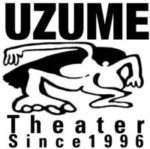→Japanese page
Written by Yukio Mishima
Direction by Peter Goessner
Performance date: April 1996
Place of performance:Move (Kitakyushu City)
Author; Yoko Matsuo
Date of writing; October 2016.
Peter came to Tobata (Tobata Ward, Kitakyushu City, Fukuoka Prefecture) and overcame the agony of not being able to create a play for about three years to launch the Uzume Theater, his first theater group.
The play is a gorgeous in Japanese by Yukio Mishima,one of Japan’s most famous literary writers and the subject matter of the play is Hitler, a man that Germans would not be able to avoid.
The first thing I did was to look for actors. I scouted around for actors by looking at plays by theater companies in Kitakyushu City.
He scouts Kyoko Yamaguchi of the Theater company “benisyouga” in Kitakyushu City for Hitler.
Yasushi Eguchi , who was a member of a theater company in Fukuoka City at the time, played Krupp, the president of a steel company who manipulates Hitler to make a fortune.
Hitler’s close ally and leader of the assault team, Rehm, is betrayed and purged by Hitler, and Yukari Tsubohara played Rehm.
And the commander of the assault team, Strasser, is played by Peter himself.
The casting of Hitler and Rehm, a strong and powerful man, is a bold move to woman. Especially Tsubohara, who played the role of Rehm, was a cute girl of about 20 years old at the time, saw a flyr recruiting members of the theater company, applied for the role, and became the first member of the Uzume Theater Company.
As is often the case in regional cities, not only in Kitakyushu, there were not many man in the theater. It could be said that the casting took advantage of this situatione.
This was the first time I became involved with the Uzume Theater.
I had just applied to join a theater company organized by Kyoko Yamaguchi, who played the role of Hitler, and Peter appeared at the meeting and talked at length about the play of Mishima. I don’t remember much about the story because it was so sudden and unexpected, but he opened the photo of the Golden Pavilion in the Japan Times in front of me , and we talked for a while about Mishima’s relationship with the Golden Pavilion, since that was the year when Asahara, the Aum Shinrikyo leader, was arrested, he asked me, “The Japanese don’t think that terrorism has anything to do with it. I think he was suggesting that this play should be performed in today’s unstable social situation in Japan (as of 1996), saying, “But there’s the Aum terrorist attack, isn’t there? To me, it seemed rather abrupt and unexpected, but he invited me in the project as a staff member.
I had been on stage a few times before, but I didn’t know much about the work of the staff, so I had to work behind the scenes, going to right to left and down. The production was run by a volunteer group called “Small Earth Society”. It was the first time for them to produce a play, so I think it was very difficult.
Stage design was done by Fukuoka artist Murakami Masaru. In the center of the stage, there was a floor covered with what looked like an archery target, with actors coming and going from a large red and black box on stage, and in the middle of the stage, a golden telegraph pole-like pole hung diagonally across the stage, Rehm climed up when he is distress.
It was both abstract and massive, reminiscent of a big magic show. I was surprised that the staging was able to show the tactics of the four characters in this way. In the scene where Rehm is killed, the staging is reminiscent of seppuku. A local rock band played loudly to liven things up and show us that Rehm was ready to die. We were joined by members of the local poetry club, and the scene of about 20 elderly men and women dressed in black mourning clothes moving around the stage and reciting was memorable. I think the show got off to a good start for a flagship show, attracting nearly 1,000 audience members, probably due to the buzz it generated.
At the time, when “life-sized plays” were in vogue, there were few literary plays about historical figures, so this was a different kind of performance. Moreover, I was surprised to see a stage production in Kitakyushu that was unlike anything I’ve seen before, where the four characters’ worldviews were set up in collaboration with abstract art. I had been convinced that such a thing could only be done by a large theater company in Tokyo, but after witnessing the fact that such a thing was possible if the direction of the director was clear, I felt that it was possible to do it and discovered the possibilities of theater in the provinces.
This play made me want to see what the director Peter Goessner would do in the future, and I became deeply involved with the Uzume Theatre.
